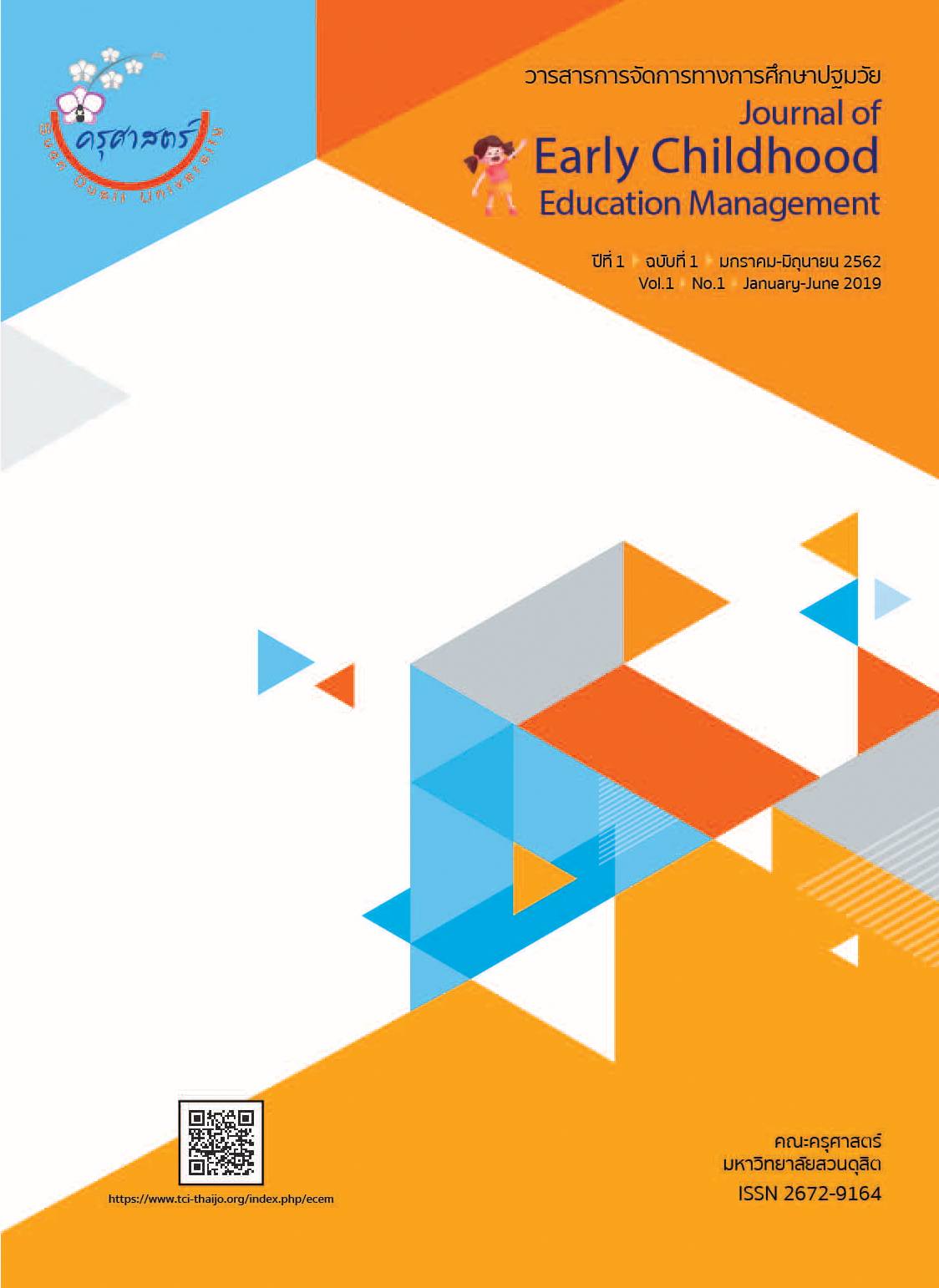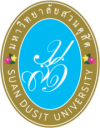Getting started right: Effective transition for children with disabilities in early childhood
DOI:
https://doi.org/10.14456/jecem.2019.5คำสำคัญ:
การส่งต่อ, เด็กปฐมวัยบทคัดย่อ
Changes are common matters that everyone encounters as a part of life. Transition means changing from one stage to another. All of us experience transition because we move through these changes throughout life. Yet, not all of us can achieve a successful transition, especially children who have disabilities. During transition, these children have difficulty crossing the boundaries from their comfort zone to the new strange zone. Examples could include moving to a new school, meeting new people, adjusting to new routines, learning to follow new rules, learning new academic skills, and other issues that involve any form of change in their environment or routine. Hence, the stress can be overwhelming when they must face these changes. Transition planning has lacked attention; even though it is emphasized to support these children to become successful by adjusting to and managing the changes in their lives. This paper focuses on compiling various literature reviews and evidence-based practices related to transition preparation in early childhood education for children with disabilities. It is important to draw ourselves into the beginning stages of educational and developmental learning.
This paper is divided into seven main discussions for understanding: (1) What is transition?, (2) Why is transition important in early childhood?, (3) Children with disabilities and the five domains of development, (4) Challenge transition for children with disabilities, (5) Preparing children with disabilities and families for transition, (6) The benefits of transition planning, and (7) Summarized keys of transition. Transition planning is like building a strong bridge for children to cross towards their future lives. Therefore, an effective transition is a good start towards encouraging greater success
in children’s lives.
เอกสารอ้างอิง
Brostrom, S. (2005). Transition problems and play as Transitory activity. Australian Journal of Early Childhood, 30(3), 17–25.
Cook, R.E., Klein, M.D., &Tessier, A. (2008). Adapting early childhood curricula for children with special needs (7th ed.). Upper Saddle River, NJ: Merrill/ Prentice Hall.
Dragoo, K. E. (2017). The Individuals with Disabilities Education Act (IDEA), Part B: Key statutory and regulatory provisions. Congressional Research Service. Retrieved from https://fas.org/sgp/crs/misc/R41833.pdf
Dunlop, A. W., & Fabian, H. (2007). Informing transitions in the early years: Research, policy, and practice. Berkshire: Open University Press.
Ebbeck, M., Saidon, S., Rajalachime, G., & Teo, L. (2013). Children’s voices: Providing continuity in transition experiences in Singapore. Early Childhood Education Journal, 41, 291-298.
Garcia, M., & Neuman, M. (2010). Early childhood development. The World Bank and Africa Region Human Development. Retrieved from http://siteresources.worldbank.org/EXTAFRREGTOPEDUCATION/Resources/444707-1291071725351/ECCD-factsheet-final.pdf
Goldberg, P. (2010). Early childhood transition guidebook: What you need to know before your child’s third birthday. MN: PACER Center.
Harper, L. J. (2016). Supporting young children’s transition to school: Recommendations for families. Early Childhood Education Journal, 44, 653-659. DOI: 10.1007/s10643-015-0752-z
Johnson, C. (2001). Supporting families in transition between early intervention and school-age programs. Colorado Families for Hands and Voices. Retrieved from http://www.handsandvoices.org/pdf/trans_cheryl.pdf
Kagan, S., & Neuman, M. (1999). Lessons from three decades of transition research. The Elementary School Journal, 98(4), 365–380.
Kids Matter. (2012). Transition matters: A resource about starting school for early childhood educators and school staff. The Australian Government Department of Health, Ageing, and beyond blue: Commonwealth of Australia. Retrieved from https://www.kidsmatter.edu.au/sites/default/files/public/KMP20130228_TransitionMatters_0.pdf
Lam, M. (2014). Transition to early childhood education: Parents’ use of coping strategies in dealing with children’s adjustment difficulties in Hong Kong. Australasian Journal of Early Childhood, 39(3), 111-120.
Macaulay Child Development Centre. (2014). Including children with special needs: a guide for family resource programs. United Way. Retrieved from file:///C:/Users/RESOFFICE/Desktop/PECERA/articles/children%20with%20disabilities/including-children-with-special-needs1.pdf
Margetts, K. (2007). Understanding and supporting children: shaping transition practices. In Dunlop, A. and Fabian, H. (eds) Informing transitions in the early years: research, policy and practice. Maidenhead: Open University Press.
Morrison, G. S. (2008). Fundamentals of early childhood education. Columbus Ohio: PEARSON Prentice-Hall.
Noel, A. M. (2010). Perceptions of school readiness in one Queensland primary school. Australasian Journal of Early Childhood, 35(2), 28–35.
Ozkan, M., Senel, S., Arslan, E.A., & Karacan, C. D. (2012). The socioeconomic and biological risk factors for developmental delay in early childhood. European Journal of Pediatrics, 171,1818-1821. DOI: 10.1007/s00431-012-1826-1
Phillips, D. (2012). Early childhood development and disability: A discussion paper. World Health Organization and Unicef. Retrieved from http://apps.who.int/iris/bitstream/handle/10665/75355/9789241504065_eng.pdf;jsessionid=9C7A1EB09579AE32FB03A173FD7F0FA9?sequence=1
Poon, J. K., LaRosa, A. C., & Pai, G. S. (2010). Developmental delay: Timely identification and assessment. Indian Pediatrics, 47, 415-422.
Quintero, N., & McIntyre, L. L. (2011). Kindergarten transition preparation: A comparison of teacher and parent practices for children with autism and other developmental disabilities. Early Childhood Education Journal, 38, 411-420. DOI: 10.1007/s10643-010-0427-8
Rimm-Kaufman, S. E., Pianta, R. C., & Cox, M. J. (2000). Teachers’ judgments of problems in the transition to kindergarten. Early Childhood Research Quarterly, 15, 147–166.
Rosenkoetter, S. E., Hains, A. H., & Fowler, S. A. (1994). Bridging early services for children with special needs and their families: A practical guide for transition planning. MD: Paul H. Brookes.
Schulting, A.B., Malone, P. S., & Dodge, K. A. (2005). The effect of school-based kindergarten transition policies and practices on child academic outcomes. Developmental Psychology, 41(6),860-871. DOI: 10.1037/0012-1649.41.6.860
Slentz, K. (2010). Early childhood disabilities and special education. National Association of School Psychologists. Bellingham: Western Washington University.
The Convention on the Rights of Persons with Disabilities. (2014). Training guide professional training series No. 19. New York: United Nations.
The University of Melbourne. (2008). Literature review transition: a positive start to school. Centre for Equity & Innovation in Early Childhood (CEIEC). Retrieved from file:///C:/Users/RESOFFICE/Desktop/PECERA/articles/Early%20childhood/transitionliteraturereview.pdf
Unicef. (2001). Early childhood development: The key to a full and productive life. Retrieved from https://www.unicef.org/dprk/ecd.pdf
US Department of Health & Human Services. (1987). Easing the transition from preschool to kindergarten. US Government Printing Office.
Woodhead, M., & Moss, P. (2007). Early childhood and primary education. United Kingdom: The Open University.
World Health Organization. (2007). International classification of functioning, disability, and health: children and youth version. Retrieved from file:///C:/Users/RESOFFICE/Desktop/PECERA/articles/children%20with%20disabilities/Classify%20disabilities%20ICH-CY.pdf
ดาวน์โหลด
เผยแพร่แล้ว
รูปแบบการอ้างอิง
ฉบับ
ประเภทบทความ
สัญญาอนุญาต
ลิขสิทธิ์ต้นฉบับที่ได้รับการตีพิมพ์ในวารสารการจัดการทางการศึกษาปฐมวัย ถือเป็นกรรมสิทธิ์ของคณะครุศาสตร์ มหาวิทยาลัยสวนดุสิต ห้ามผู้ใดนำข้อความทั้งหมดหรือบางส่วนไปพิมพ์ซ้ำ เว้นแต่จะได้รับอนุญาตอย่างเป็นลายลักษณ์อักษรจากคณะครุศาสตร์ มหาวิทยาลัยสวนดุสิต นอกจากนี้ เนื้อหาที่ปรากฎในบทความเป็นความรับผิดชอบของผู้เขียน ทั้งนี้ไม่รวมความผิดพลาดอันเกิดจากเทคนิคการพิมพ์




